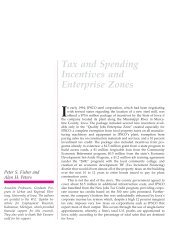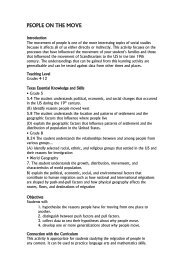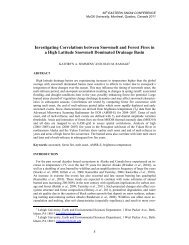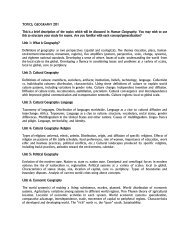Texas Social Studies Framework - Department of Geography ...
Texas Social Studies Framework - Department of Geography ...
Texas Social Studies Framework - Department of Geography ...
Create successful ePaper yourself
Turn your PDF publications into a flip-book with our unique Google optimized e-Paper software.
68<br />
68<br />
Domain VIII constitutes the Commissioner’s recommendation<br />
for the student performance link, which is required<br />
by Senate Bill 1. This domain is related to the<br />
teacher’s efforts to align instruction with <strong>Texas</strong> Assessment<br />
<strong>of</strong> Academic Skills (TAAS) skills objectives<br />
addressed within the teacher’s particular assignment, the<br />
teacher’s efforts to be proactive in addressing student<br />
attendance problems, the teacher’s efforts to intervene<br />
appropriately with students in at-risk situations, and<br />
finally, the teacher’s shared score on the overall campus<br />
performance rating.<br />
INCLUDING SOCIAL STUDIES ON THE<br />
TEACHER SELF-REPORT<br />
One <strong>of</strong> the strengths <strong>of</strong> the PDAS process is the input<br />
that teachers have into their appraisal through the<br />
Teacher Self-Report form. The focus <strong>of</strong> the Teacher Self-<br />
Report is on TAAS skills objectives in the areas <strong>of</strong><br />
reading, writing, and mathematics. This is because <strong>of</strong> the<br />
state focus on academic skills, as well as the fact that<br />
student passing rates on the TAAS tests in these subject<br />
areas are part <strong>of</strong> the AEIS indicators that are factored into<br />
the campus performance rating. The campus performance<br />
rating is considered in the scoring <strong>of</strong> the teacher’s<br />
performance in Domain VIII.<br />
When completing the Teacher Self-Report form, teachers<br />
are asked to identify TAAS objectives that they address<br />
in their instructional programs. This ensures that the<br />
PDAS is directly connected to the subject matter and<br />
routine instructional activities found in the classroom.<br />
For example, an economics teacher may require the<br />
students to explain in a written and visual presentation<br />
how technological innovations have changed the way<br />
goods are manufactured, marketed, and distributed in the<br />
United States. The teacher may ask the students to<br />
analyze economic trends from a variety <strong>of</strong> texts (reading),<br />
demonstrate an understanding <strong>of</strong> the basic principles<br />
<strong>of</strong> production, consumption, and distribution <strong>of</strong><br />
goods (number concepts/math), demonstrate the ability<br />
to interpret economic data (cross-discipline), and<br />
organize ideas in a written and visual presentation<br />
(writing).<br />
The purpose <strong>of</strong> the Teacher Self-Report is not limited to<br />
addressing only those academic skills in reading, writing,<br />
and mathematics. While these are the minimum standards<br />
required for completion <strong>of</strong> the Teacher Self-Report form,<br />
the PDAS emphasizes collaboration among teachers<br />
regarding instruction that is aligned with the academic<br />
Chapter 6: Aligning the TEKS for <strong>Social</strong> <strong>Studies</strong> with the PDAS<br />
skills objectives for social studies and other content areas<br />
across the curriculum. Collaboration among teachers at<br />
all grade levels and content areas is frequently cited in<br />
the PDAS as an expected level <strong>of</strong> performance to receive<br />
an Exceeds Expectations score in several <strong>of</strong> the Domains.<br />
The Teacher Self-Report is an excellent way for social<br />
studies teachers to communicate with their appraiser and<br />
to provide evidence and documentation <strong>of</strong> their efforts in<br />
this area.<br />
STAFF DEVELOPMENT ACTIVITY<br />
An example <strong>of</strong> an alignment strategy follows (see<br />
Figure 34). This particular example shows the alignment<br />
<strong>of</strong> the TEKS for a high school U.S. history lesson with<br />
the criteria in several <strong>of</strong> the PDAS domains. Notice how<br />
the objectives, strategies, and assessment for the lesson<br />
are specifically aligned with the social studies strands,<br />
including developmentally appropriate social studies<br />
skills for that grade level, and Domains I, II, III, and VIII<br />
<strong>of</strong> the PDAS evaluation criteria.<br />
The template used in Figure 34 can be incorporated into<br />
a staff development activity for social studies teachers<br />
across grade levels and content areas. Using the template<br />
as an organizer for lesson planning, teachers complete<br />
the first four columns <strong>of</strong> the template by filling in the<br />
components <strong>of</strong> a lesson they frequently use, including<br />
TEKS site, objectives, strategy, and assessment. Once<br />
completed, teachers analyze the lesson plan to ensure<br />
that there is an integration <strong>of</strong> as many <strong>of</strong> the social<br />
studies strands as appropriate, including developmentally<br />
appropriate social studies skills for the grade level or<br />
course being taught. Next, teachers evaluate the alignment<br />
<strong>of</strong> the lesson plan with the evaluation criteria <strong>of</strong> the<br />
PDAS domains (included in the last column <strong>of</strong> the<br />
template). Using the Think-Pair-Share collaborative<br />
learning technique, teachers think to themselves about<br />
modifications they would make to the lesson plan to<br />
ensure alignment; they pair up with another teacher to<br />
discuss their ideas; then the pair shares their thoughts<br />
with the entire group.<br />
The ultimate goal <strong>of</strong> this staff development activity is for<br />
teachers to learn a strategy for planning effective social<br />
studies instruction while at the same time meeting the<br />
expectations <strong>of</strong> the PDAS evaluation criteria. Appraisers<br />
trained in the PDAS framework will be looking for<br />
evidence and documentation <strong>of</strong> alignment as they<br />
evaluate a teacher’s performance throughout the school<br />
year.
















